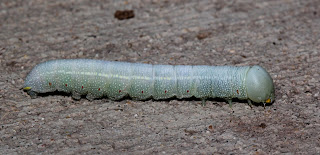It's only one of numerous signs that summer is ending. The Carolina mantis does not survive the winter, but it has been slaughtering insects all summer to build up the resources to fashion its hard woody egg cases to make sure its eggs survive winter to start the new generation next year. However preserving life over the winter season is full of risks. Here, a small parasitic wasp wants to insure the future of its eggs too, and it is laying them inside the nest so its larvae can feed on the mantis eggs. If you look closely you can see the wasp's ovipositor seemingly coming out of the base of its abdomen.
This is also the time when many caterpillars (such as this White-dotted Prominent) are wandering, looking for a safe place to pupate. Its a time of high risk for them as well, because they are more visible than usual. It's when we pick up several to keep in an aquarium over winter to see them eclose in the spring, but it's also when The Caterpillar Hunter, a spectacular and voracious big beetle, is out looking for them.
Another sign: Suddenly Crane Flies of several sizes are showing up everywhere. There are some species that are found all winter, and others at probably all times of the year, but they seem especially abundant in spring and fall, perhaps liking cooler weather. They look rather like mosquitoes in shape. Indeed some are as small and frail as mosquitoes. But the one you are likely to notice right now is a giant with a leg span of three-and-a-half inches. Whatever the size, they are all totally harmless creatures. In folk-science, which goes by appearance rather than behavior, the big one is called a "skeeter hawk" because it is thought to hunt down and kill mosquitoes.
A few rather showy butterflies are making their plans. Question Marks for example are emerging now in their exquisite fall "orange" version. Those that live on the east coast will migrate south, but around here I believe most overwinter in buildings or under bark or similar places, and come out early in spring. They mate then and create the "black" summer version, which lays eggs for the fall overwinter generation.
Another example is the Mourning Cloak, which I was surprised to see basking in my front yard lately. It was already a little banged-up looking, which also surprised me, because it was in the generation that was going to overwinter and breed next spring. I know at the end of winter they are torn and scraped, but I didn't know they went into winter already aging. So I read up on their confusing life history, and this is how I understand it: That overwintered generation breeds, lays eggs, and dies in the spring. The new brood ecloses as adults in mid summer and immediately aestivates (that was certainly a good strategy this summer) and comes out now when I saw this one, and either migrates southward, or overwinters here hidden away in shelters like the Question Mark. After we saw that one in our yard, we went out to Big Lake a few days later, and in the large open area of a wetland we noticed three or four passing by as if migrating. So for a short time in spring, sometimes for a short time in mid summer, and sometimes for a short period in fall, they are visible to us.
The Cloudless Sulphur, a very large butterfly with bright yellow wings in flight, and the Gulf Fritillary, a beautiful red-orange butterfly with silver teardrops on the underwing, are both year-round residents of the Gulf states, and because it's warm there all year, they have no strategy for getting through winter. In the summer, generation by generation they work their way north, reaching us later in the summer, and blissfully go on laying eggs and raising caterpillars till the frost kills them off. Well, some may move south. I don't think anyone knows for sure. They're beautiful to have in the yard, but it is a bit grim watching them and not being able to warn them the first frosts are coming.
Here is a rather plain little butterfly, the Ocola Skipper, that also works its way north from the Gulf states generation by generation, ending up here late in summer. It looks like a number of other small brown skippers, except it has exceptionally long forewings. It also has no way of getting back south again.
Why do these species come all the way up here, if even their best efforts to breed up a population will come to nothing? Perhaps after all they will have the last laugh as a warming climate moves north. They are pioneers. They will be the first to take over the new territory. When we moved to this house 35 years ago, the USDA Plant Hardiness Zones showed Jonesboro to be at the very top of Zone 7a. The Common Buckeye (abundant in fields right now), cannot survive the winter north of Zone 8. Well, now Jonesboro, 35 years later, is in Zone 7b, half the way down to Zone 8.
So if I can hold on for another 35 years, I might have the sub-tropical climate I always wanted to live in.













No comments:
Post a Comment